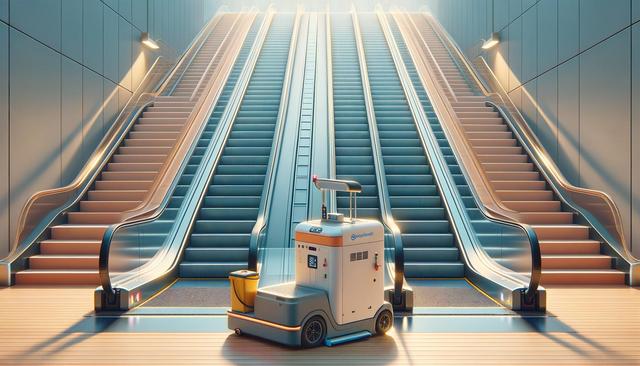Understanding the Role of Escalator Cleaning Machines in Public Hygiene
In high-traffic public environments like malls, transit stations, and airports, escalators accumulate dust, debris, and germs at a rapid pace. Escalator cleaning machines have become essential tools in maintaining the hygiene and safety of these areas. These machines are specifically engineered to clean the intricate structure of escalator steps and grooves, which are otherwise difficult and time-consuming to clean manually. By automating the cleaning process, facility managers can ensure that surfaces remain sanitary and presentable without disrupting public use.
These machines work by employing a combination of brushes, vacuum technology, and cleaning agents to remove contaminants efficiently. Designed to match the dimensions of standard escalator steps, they can clean horizontal and vertical surfaces simultaneously. This level of precision helps reduce the risk of slips, bacterial transmission, and mechanical wear caused by debris buildup, directly contributing to a safer environment for all users.
Operational Efficiency and Cost-Effectiveness
One of the key advantages of escalator cleaning machines is their ability to deliver consistent results with minimal human intervention. Traditional cleaning methods require significant manpower and time, often involving partial disassembly of the escalator system. In contrast, these automated solutions can be deployed during off-peak hours and complete the task in a fraction of the time, minimizing downtime and disruption to public services.
From a financial perspective, investing in escalator cleaning machines can result in long-term savings. Reduced labor costs, lower maintenance needs, and extended equipment lifespan all contribute to operational efficiency. Facility managers benefit from predictable cleaning cycles, which can be scheduled during non-operational hours to avoid inconveniencing the public.
- Shorter cleaning times
- Lower risk of escalator malfunctions
- Decreased reliance on manual labor
Safety Features and User-Friendly Design
Escalator cleaning machines are designed with safety and ease of use as priorities. Most models are equipped with built-in sensors, emergency stop functions, and automatic shut-off systems to prevent accidents. These features help ensure the safety of cleaning staff and protect the machinery from damage due to operational errors.
Many machines also come with user-friendly interfaces, allowing operators to adjust settings based on escalator type, cleaning intensity, or schedule. Lightweight and portable designs further enhance their usability in large facilities where multiple escalators need servicing. The combination of intelligent design and safety protocols makes these machines a practical choice for routine maintenance operations.
- Emergency stop buttons for quick halting
- Adjustable cleaning modes
- Portability for multi-site usage
Environmental Considerations and Sustainability
As public infrastructure increasingly adopts sustainable practices, escalator cleaning machines are evolving to meet environmental standards. Many modern units use eco-friendly cleaning agents and water-efficient systems to reduce resource consumption. Some machines feature recyclable components or energy-saving modes, aligning with green building certifications and environmental policies.
Using these machines contributes to healthier indoor air quality by removing dust and allergens that can accumulate on escalator surfaces. Their ability to perform deep cleaning without harmful chemicals supports broader public health and sustainability goals, making them a responsible choice for facility maintenance teams.
- Low water and energy consumption
- Use of biodegradable cleaning solutions
- Support for green facility initiatives
Choosing and Implementing the Right Solution
Selecting the appropriate escalator cleaning machine depends on several factors, including the size of the facility, frequency of use, and cleaning requirements. Facility operators should consider features such as brush type, suction power, tank capacity, and compatibility with different escalator brands when evaluating options. Conducting a site assessment and consulting with equipment specialists can help ensure the machine meets operational needs.
Once a suitable machine is chosen, staff training and regular maintenance are key to maximizing its effectiveness. Operators should be trained on proper setup, usage, and troubleshooting techniques. Additionally, manufacturers often provide service packages to ensure the machine operates at peak efficiency over its lifespan. Implementing a structured maintenance plan helps avoid unexpected breakdowns and keeps escalators safe and clean for daily use.
- Assess facility needs and escalator dimensions
- Evaluate machine features and specifications
- Provide comprehensive staff training
Conclusion: Enhancing Public Safety Through Smart Maintenance
Escalator cleaning machines offer a reliable, efficient, and safe solution for maintaining cleanliness in high-traffic public spaces. By automating a traditionally labor-intensive process, these machines support facility managers in delivering hygienic and well-maintained environments. With features that enhance safety, reduce costs, and promote sustainability, they represent a forward-thinking approach to public infrastructure maintenance. Investing in such technology not only preserves escalator performance but also reinforces a commitment to public health and safety.




Leave a Reply